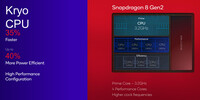Qualcomm Snapdragon 8 Gen 2 for Galaxy vs Google Tensor G2
Qualcomm Snapdragon 8 Gen 2 for Galaxy
► remove from comparison
The Qualcomm Snapdragon 8 Gen 2 for Galaxy Mobile Platform is a high-end SoC for smartphones that was introduced in late 2022 and manufactured in 4 nm at TSMC (N4P). It integrates four different CPU clusters. A fast and big prime core based on the ARM Cortex-X3 architecture and clocked at up to 3.36 GHz for 64 bit applications. Two more ARM Cortex-A715 based performance cores clocked at up to 2.8 GHz (also only for 64 bit apps). Two more Cortex-A710 performance cores at up to 2.8 GHz that can also be used for older apps and three efficiency cores (ARM Cortex-A510 with up to 2 GHz). All cores can use the shared 8 MB level 3 cache. Compared to the normal SD 8 Gen 2, the "for Galaxy" version offers a 160 MHz higher clocked prime core.
Thanks to the new architecture and high clock rates, the SD 8 Gen 2 is the fastest mobile CPU for Android based devices and is only topped by current Apple SoCs like the Apple A16 (see benchmarks below).
The chip also integrates a Hexagon accelerator for AI workloads (tensor, scalar and vector). Qualcomm states that its one of the first chips with INT4 support and up to 4.35x performance compared to the previous generation.
The 18-Bit-Spectra ISP is able to process photos with up to 200 MP and work with videos up to 8k30 (including 10-bit, HDR10+, HLG and Dolby Vision).
A big improvement of the Snapdragon 8 G2 is the integrated Adreno 740 GPU, that now supports Hardware Raytracing and tops even the iGPU in the Apple A16.
The integrated AI Engine can offer up to 4x faster AI performance thanks to the bigger Tensor engine. The 18-Bit-Spectra-ISP also saw some big improvements and is now called Snapdragon Sight.
The integrated Adreno 730 offers a 30% graphics boost compared to the previous Adreno 660.
The integrated Snapdragon X70 5G modem is also new as is the FastConnect 7800 modem with Wi-Fi 7 and Bluetooth 5.3 support.
Google Tensor G2
► remove from comparison
The Google Tensor G2 SoC is a chip that was developed by Google and Samsung for the Google Pixel smarthpones. It is the successor to the Google Tensor G1 and still integrates the same CPU cores. This processor part includes two fast ARM Cortex-X1 cores at up to 2.85 GHz (up from 2.8 GHz of the G1), two mid-range Cortex-A78 cores at up to 2.35 GHz and four small ARM Cortex-A55 efficiency cores with up to 1.8 GHz. The caches are identical with 4 MB CPU L3 cache and 8 MB system level cache. Therefore, the CPU performance is very similar to the first generation of the Tensor SoC.
A big upgrade is the new TPU, which should be more powerful and power efficient compared to its predecessor. In our tests, the AI performance is about 50% higher.
The iGPU was also improved, and now uses a more modern ARM Mali G710 architecture with 7 cores.
The chip also integrates a Titan M2 security processor, a LPDDR5 memory controller, and an ISP for 10-bit HDR / 4k/60 video and 108 MP cameras.
The SoC is manufactured in 5nm at Samsung.
| Model | Qualcomm Snapdragon 8 Gen 2 for Galaxy | Google Tensor G2 | ||||||||
| Codename | Cortex-X3 / A715 / A710 / A510 (Kryo) | Cortex X1 / A76 / A55 | ||||||||
| Series | Qualcomm Snapdragon 8 | |||||||||
| Series: Snapdragon 8 Cortex-X3 / A715 / A710 / A510 (Kryo) |
| |||||||||
| Clock | 2000 - 3360 MHz | 1800 - 2850 MHz | ||||||||
| L3 Cache | 8 MB | 4 MB | ||||||||
| Cores / Threads | 8 / 8 1 x 3.4 GHz ARM Cortex-X3 2 x 2.8 GHz ARM Cortex-A715 2 x 2.8 GHz ARM Cortex-A710 3 x 2.0 GHz ARM Cortex-A510 | 8 / 8 | ||||||||
| Technology | 4 nm | 5 nm | ||||||||
| Features | Adreno GPU, Spectra ISP, Hexagon, X70 5G Modem, FastConnect 7800 Wi-Fi 7, LPDDR5x 4200 MHz Memory Controller | ARM Mali-G78MP20 GPU | ||||||||
| iGPU | Qualcomm Adreno 740 | ARM Mali-G710 MP7 | ||||||||
| Architecture | ARM v9 | ARM | ||||||||
| Announced | ||||||||||
| Manufacturer | www.qualcomm.com | store.google.com |
Benchmarks
Average Benchmarks Qualcomm Snapdragon 8 Gen 2 for Galaxy → 100% n=27
Average Benchmarks Google Tensor G2 → 64% n=27
* Smaller numbers mean a higher performance
1 This benchmark is not used for the average calculation












